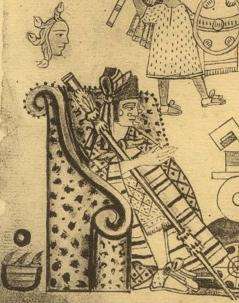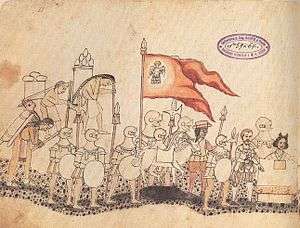Codex Azcatitlan


The Codex Azcatitlan details the history of the Mexica from their migration from Aztlán to the Spanish conquest of Mexico and Christianization. The exact date it was written is not known, it is presumed it was written sometime between the mid 16th and 17th centuries.
Contents
The text consists of pictorial Aztec codex, with pictorial representations and glyphs accompanied by Nahuatl gloss, with Latin characters descriptions, the story told.
It is composed of three parts.
The first deals on an analytical mode the Aztec history since leaving the legendary Aztlán (a gloss mentions the name of Azcatitlan) in year 1-Pedernal (Flint) (gloss designated as 1168) until the Tenochtitlan founding.
The second part deals with the Aztec Tlatoanis history.
The last part, quite diverse, deals with the arrival of the Spanish and the beginnings of the conquest of the Aztec Empire.[1]
Style
The codex contains stylistic innovations such as volume and space suggestion, using color attenuation for this purpose. Remarkably, the drawings depict clothing folds, as well as an empirical perspective as well as composition.
Name
Unlike most other Mesoamerican codices, the name of this codex is not one of its owners, but its contents. Indeed, it is drawn with a Gloss indicating that the place of departure of the Aztec migration is Azcatitlan (derivative of Aztlan).
Characteristics
It consists of 25 European paper 21 x 28 cm sheets (50 pages),[2] painted on both sides.
All pages contain color drawings and are in excellent state of preservation. Six pages of this document are lost and it is known they are missing since ancient times. The document was restored in 1959.
The codex is fastened in the European style.
History
The first document information is in the "Indian Historical Museum" catalogue (1702–1755) and it was owned by Lorenzo Boturini Bernaducci. This famous collector personally bought indigenous codices and when he was arrested and subsequently deported Spain, his collection was confiscated.
Subsequently the Codex is mentioned in the 19th century by Joseph Marius Alexis Aubin, who later sold his collection to Eugène Goupil. Upon his death, his widow donated the codex to the Bibliothèque nationale de France in 1898.
Authors
The authors and the date of preparation of this document are unknown, but several elements show that it is a colonial codex.
In fact, the binding method and painting style, mixing indigenous and European artistic conventions,[1] notably by the use of perspectives,[3] suggest that the book is not earlier than the second half of the 16th century.[1]
Michel Graulich considers the glosses are contemporary paintings and note the handwriting of these glosses resembles the style of other works of the last third of the 16th century.[1]
The codex seems to have been made by at least two painters-scribes (Tlacuiloque[4]) with different styles.[5]
References
- 1 2 3 4 Herren :2004, pg. 8
- ↑ Manuel Aguilar-Moreno, "Handbook to Life in the Aztec World", Oxford University Press, 2007, pp. 267
- ↑ Can be noticed in the temple representation, in the Aztlán departure scene on the board II (Herren: 2004, pg. 10).
- ↑ "Tlacuilo" (pl. "tlacuiloque") is a Nahuatl word that refers to a painter scribe of Mesoamerican codices. The pre-Hispanic era, they were members of the aristocracy ("pipiltin").
- ↑ Codex Azctatilan, 1995, pp. 22-23 (cited by Herren, 2004, pg. 8).
- National French Library: Codez Azcatitlan
Bibliography
- Codex Azcatitlan, Introduction de Michel Graulich, commentaire de Robert H. Barlow mis à jour par Michel Graulich [comment by Robert h. Barlow put updated by Michel Graulich] Bibliothèque nationale de France-Société des Américanistes, Paris, 1995. (French)
- Herren, Angela Marie, Portraying the Aztec Past in the Codex Azcatitlan: Colonial Strategies, Athanor Num. XXII, History and Art Department of the State of Florida University, 2004.
Further reading
- Aztecs
- Aztlán
- Mesoamerica
- Mesoamerican codices
- Spanish conquest of the Aztec Empire
- Nahua peoples
- Aztec codices
- Lorenzo Boturini
External links
- Famsi.org: Links to page-by-page views of Codex Ixtlilxochitl
- Thing.net: Detailed interpretation, with annotated photos, of the last pages of the Boturini Codex
- Library.albany.edu: Bibliography of Mesoamerican Codices